2014 KTM 1190 Adventure Review
A more technologically streetable Adventure-Tourer
When it came to big-bore Adventure-Touring shootouts, the KTM 990 Adventure was predisposed to win the off-road segment of the test. That motorcycle, with 21-inch front and 18-inch rear wheels, 8.25 inches of suspension travel (front and rear), and a lesser wet weight than its peers was simply better suited to the task.
“The KTM 990 Adventure is the only real choice if your idea of adventure takes you far away from the pavement,” said Dean Hight in our 2012 Adventure-Touring Shootout.
The old Adventure, however, was outpaced, technologically bereft and suffered from displacement envy. With the introduction of the 2014 1190 Adventure, KTM addressed the bike’s shortcomings but in the process has streetified its once dominant dirtbike.
Before we go any further, dirt-o-philes need not fret because an R version of the 1190 Adventure is on the way and it promises to be everything off-road the standard version is not. We’ll have a review of the 1190 R Adventure immediately following the Adventure Rider Rally in Steamboat Springs, Colorado, but for now let’s expose the new nature of KTM’s standard Adventure model.
2013 Ducati Multistrada 1200 S Touring Vs. 2013 Triumph Explorer – Video
With the likes of Ducati’s Multistrada and Triumph’s Tiger Explorer gaining in popularity while also blurring the lines of what comprises an Adventure-Tourer, KTM set to hybridizing its new Adventure model. Wheel sizes are reduced from the 990’s 21/18 combo to 19 and 17 inches, front and rear, respectively, engine displacement increased from 999cc to 1195cc, and a slipper clutch was added to the new 6-speed transmission. An electronics package including electronically adjustable suspension, R-b-W throttle, Motorcycle Traction Control (MTC), switchable ABS and Ride Modes is present. Adjustable windscreen, seat and handlebars conspire to easily customize comfort levels, while a steering damper helps keep the long-travel fork calm as the speeds increase.
Engine, MTC, Transmission & Slipper Clutch
KTM claims 150 horsepower from the 1195cc 75° V-Twin powering the Adventure. Calculating a pessimistic 15% drivetrain power loss (-27.5 hp) puts the LC8-based engine well above the Tiger Explorer’s 111 hp and in the neighborhood of the Multistrada’s 131 hp – a promising start for the new bike.
The DOHC four-valve cylinder heads feature two differently sized spark plugs per cylinder controlled by dual ignitions that ignite the spark plugs independently of one another. KTM claims the result is a 20% improvement in fuel economy and reduced emissions.
While there’s significant low-end power, a noticeable power surge resides above 6000 rpm. The increased propulsion is nice to have on tap, but the vibes that come with it are not. After an extended period of high-rpm canyon riding I grabbed another gear (my ass cheeks were getting tingly) which diminished the worst of the vibrations as well as the illumination of the MTC warning light.
Engine response from KTM’s R-b-W system operating two 52mm Keihin throttle bodies feels nicely cable-like, while minor throttle inputs (largely unnecessary due to its traction control system) results in smooth, controllable increases or decreases in engine revs.
When the MTC light does illuminate, it’s oftentimes surprising. While power is momentarily delayed, there’s no sense of engine surging, making the system’s operation very transparent. There are four different MTC settings that vary according to the Rider Mode selected. MTC can also be completely disabled.
Rider Modes
| Sport | MTC is set to allow slight wheelspin with the MTC intervening late in the throttle application. Allows for small front wheel lift during hard acceleration. (150 hp) |
|---|---|
| Street | MTC is set manage the slippage in a smooth and controlled manner for increased rider confidence. (150 hp) |
| Off-Road | MTC is set to allow 100% of rear wheel slippage – up to twice the wheel speed for optimum traction in off-road conditions. (100 hp) |
| Rain | 100% MTC, no rear wheel slippage. (100 hp) |
Also based on the RC8, the Adventure’s crankcase was modified with a different valve train and camshafts that helped reduce its weight. Gear ratios were changed with a much shorter first gear for slow-speed maneuvering while 5th and 6th are overdrive gears for touring purposes. An oil sight glass was installed at the left front, right below the oil intake and above the oil filter.
Helping with aggressive street riding is a Power Assist Slipper Clutch (PASC) which reduces back-torque pressure. The adjustable clutch lever requires an easy pull due to incredibly light clutch springs.
In fact, the whole shifting experience on the Adventure was pleasurable without any unwarranted missed shifts or false neutrals. And, if so desired, the Adventure is set up for the installation of the KTM quick shifter available from KTM accessories.
Electronic Suspension & Multi-Functional Cockpit
KTM’s first suspension featuring an Electronic Damping System (EDS) comes by virtue of WP Suspension. Like similar units a rider can, via the handlebar-mounted mode switch, adjust preload settings according to load (Solo, Solo with luggage, Two-up, Two-up with luggage).
Separate from the preload are three damper settings: Sport, Street and Comfort. These are also selected from the handlebar-mounted mode switch and change the performance of suspension characteristics accordingly.
Like similar models we’ve sampled, WP’s version of electronic damping provides a balanced blend of suspension tuning to keep most motorcyclists happy with the pre-set damping selections. During our short ride we didn’t find any egregious suspension flaws, but we reserve the right to change our opinion after having a model under our butts for a longer period of time.
Controlling all these functions is the aforementioned Multi-Functional Cockpit including the handlebar-mounted mode switch, analog tachometer, a digital speedometer, and an LCD screen with readouts for fuel and engine temp, clock, preload selection, etc., and a separate screen for selecting Rider Modes, suspension settings, ABS and MTC controls and more.
While Rider Modes can be changed at any speed and activated after closing the throttle, ABS and MTC can only be dis-engaged at walking speeds or less, and suspension preload changed only when stopped.
Like the new BMW R1200GS, the Adventure doesn’t retain some settings, such as turning off ABS, without purchasing a special “dongle” from the KTM parts catalog.
Brakes, Adjustability & Other Stuff
Slowing the new Adventure are dual, radially mounted, 4-piston Brembo calipers gripping 320mm discs up front and a 2-piston Brembo caliper and 268mm disc out back. At both ends is Bosch’s 9ME Combined ABS/C-ABS technology.
With C-ABS, when a rider applies front brake pressure the system adds rear brake pressure, but does not apply front brake pressure when a rider uses only the rear brake. ABS and C-ABS can also be turned off entirely.
ABS Settings
| Street | Fully functional ABS including C-ABS. |
|---|---|
| Off-Road | Allows a higher degree of front wheel slippage than in “Street” mode and disengages the C-ABS and rear wheel ABS so the rear wheel can be operated separately and can be stopped completely to help control the bike in off-road conditions. |
| Off | All ABS functions are turned off. |
Stopping power, especially when combined with ABS, is more than sufficient for quickly slowing the 507-pound machine. A very minimal pulsation is felt through the hand and foot brake levers when ABS engages, but otherwise, like the MTC, the ABS system functions transparently.
To address different-size riders and make long-distance touring as comfortable and convenient as possible, KTM provides adjustability in many areas. The seat easily moves from its low position (33.8 inches) to its high position (34.4 inches), while handlebars have 10mm of adjustment and footpegs move up and to the rear over a distance of 15mm. Rubber footpegs inserts are removable, providing better grip in slippery off-road conditions.
+ Highs
- Horsepower
- Electronics package
- A more well-rounded Adventure
– Sighs
- Very vibey above 8000 rpm
- No cruise control
- Hardcore dirtbike guys will scoff
The manually adjustable windscreen has a range of 25mm in vertical movement as well as a fore and aft range of 36mm. In the low setting I found the windscreen provided ample wind protection and diverted the stream over the top of my Arai XD4 helmet without catching the visor. A rider would have to be in excess of six feet tall to gain any advantage of the windscreen’s taller setting.
Considering the Adventure’s new on-road disposition, including an increased fuel load for longer, uninterrupted riding miles, we were surprised to find cruise control missing from its electronics suite. Maybe cruise control was omitted for pricing considerations, but it’s hard to speculate at this point because KTM isn’t releasing the Adventure’s MSRP until we test the R model at the Adventure Rider Rally.
Speaking of the Rider Rally, if you’d like to try the new 1190 Adventure or the 1190 R Adventure models yourself, test rides are being offered there and at select West Coast locations during the month of September. For dates and more information check the KTM website or with your local KTM dealer.
| 2014 KTM 1190 Adventure | |
|---|---|
| MSRP | TBA |
| Horsepower | 150 @ 9500 rpm (claimed) |
| Torque | 92.2 ft-lb. @ 7500 rpm (claimed) |
| Engine Capacity | 1195 cc |
| Engine Type | 75° V-Twin |
| Bore x Stroke | 105 mm x 69 mm |
| Compression | 12.5:1 |
| Fuel System | EFI |
| Transmission | 6-speed |
| Clutch | Power Assist Slipper Clutch, hydraulically operated |
| Final Drive | Chain |
| Frame | Chromium-molybdenum-steel trellis |
| Front Suspension | 48mm, WP inverted fork, electronically adjustable |
| Rear Suspension | WP monoshock, electronically adjustable |
| Front Brakes | 4-piston Brembo calipers, 320mm discs, ABS/C-ABS |
| Rear Brakes | 2-piston Brembo caliper, 268mm disc, ABS/C-ABS |
| Front Tire | 120/70-19 |
| Rear Tire | 170/60-17 |
| Seat Height | 33.8” to 34.4” |
| Wheelbase | 61.4” |
| Rake/Trail | 26°/4.7” |
| Curb Weight | 507 lbs |
| Fuel Capacity | 6.1 gal |
| Electronics | Ride Modes, R-b-W, MTC |
| Colors | Grey, Orange |
A former Motorcycle.com staffer who has gone on to greener pastures, Tom Roderick still can't get the motorcycle bug out of his system. And honestly, we still miss having him around. Tom is now a regular freelance writer and tester for Motorcycle.com when his schedule allows, and his experience, riding ability, writing talent, and quick wit are still a joy to have – even if we don't get to experience it as much as we used to.
More by Tom Roderick



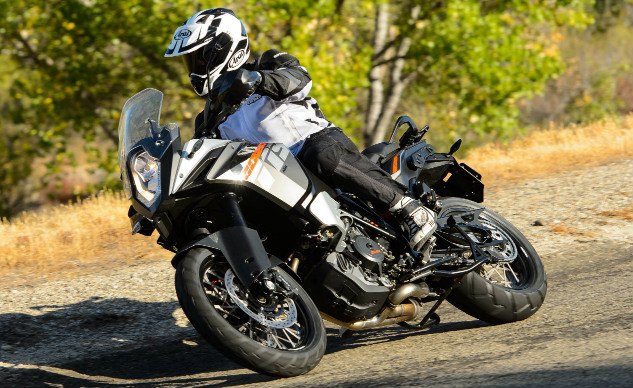
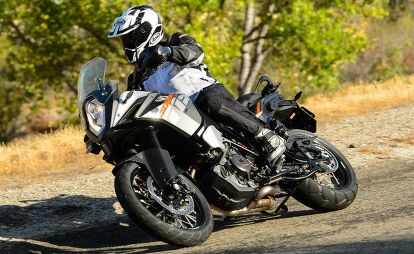

































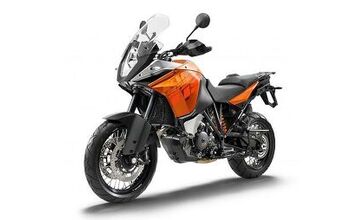

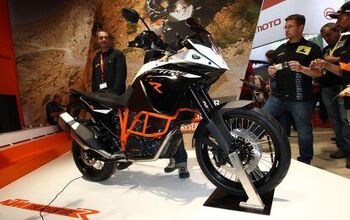
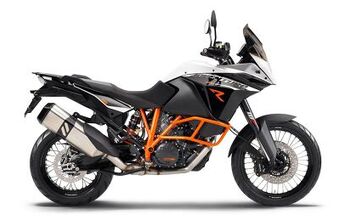












Comments
Join the conversation
With those tires and 500 plus pounds, that bike isn't going far from the beaten path. This adventure bike craze is about city riders wanting to look like jungle explorers.
Get some B---s buddy , If you can ride the bike will go were you take it...